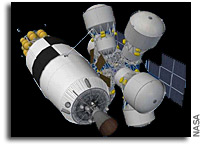Internal NASA Studies Still Favor Fuel Depot Architecture

Last year an internal NASA study that cited the advantages of fuel depots instead of using the Space Launch System emerged from inside NASA. Congress seized on the study – and NASA’s Administrator said that internal studies showed that there were no technical or cost advantages. Well, another study completed late last year has emerged from NASA that contradicts that statement.
NASA JSC Briefing: Propellant Depot Alternate DRM 34B – Mission Risk, Reliability, and Availability Analysis
HAT/Depot Team TIM November 2, 2011
Download full document (Excerpts)
Initial risk assessment results (March 2011) indicated:
– Very low additional risk for propellant delivery with contingency missions
– Other system-level effects could offset this additional risk, resulting in a net risk decrease
– Overall system risk reduced for re-use of operational depot for multiple DRMs
– High flight rate with relatively low cost payload seen as a reliability growth benefit
– Can mitigate depot MMOD & systems risk by partially off-loading propellant for launch
– Can re-allocate mass to increase shielding, add redundancy, & use greater design margins
– Same mass reallocation technique could also reduce risk for other elements
S&MA was requested to perform reliability/risk analysis to assist in these trades
Maturation and demonstration of depot technologies should be supported due to high potential to achieve Technology Roadmap goals in Safety and Reliability
– This study does not support the perception that depots add an unacceptable level of risk and should not be considered due to the increased number of launches, AR&Ds, and transfers
Depot-based exploration missions have significant potential to reduce total Endto-
End Loss of Mission (LOM) and Loss of Crew (LOC) risks
– There are still many unknowns such as actual reliability of future propellant transfer
– Analysis results are very preliminary with both positive and negative effects that have not been fully quantified at the present time and will depend on actual implementation
Depot element may be added without significantly increasing total risk
– Depot reuse can minimize launch risk due to a single launch supporting multiple missions
– Depot element on-orbit risk can be minimized by robust design and planning for maintenance
Risk due to multiple supply missions can be effectively managed
– Propellant delivery reliability with contingency can equal or exceed single mission reliability
– Possible even with less reliable launch vehicles than normally required for crew or high value/long lead cargo
– Consequence for loss of relatively low value propellant can be low
– Net risk acceptable even if likelihood were elevated with low cost vehicles
– “Loss of Opportunity” analysis and alternate destinations should be considered
– A minimum of two contingency missions by two separate providers using two separate facilities should be considered mandatory (but equal use of both in this case was sub-optimal)
Although some risk is likely increased at the beginning of the mission, depot-based architectures have potential to significantly reduce risk for mission phases following propellant delivery
Added flexibility enables alternate mission planning, design, and support options Improves ability for optimization of “End-to-End” risk by enabling or facilitating additional options that can:
– Reduce total number of other elements
– Eliminates unreliability of unnecessary elements (such as 2nd CPS, 2 SEPs)
– Decrease total mission time (eliminate need for slow SEP transfers)
– Less time with “reliability clock” running Beneficial effects can easily exceed any risk increase for depot/prop delivery
– Driver for improvement is that there are opportunities for elements and missions to be designed and operated in fundamentally different ways than without depots
– Architectures, missions, elements, and processes should be optimized differently to take best advantage of these opportunities to reduce mission risk and increase safety
Improvement evident even without including other effects such as:
— Reliability growth, maturity, improved robustness, increased maintenance capability
— Opportunity for additional crew safety systems and environment countermeasures
— Potential for depot to serve as “safe haven”, providing backup power, etc. prior to departure
— Human reliability likely better for ground/mission personnel with constant vs. surge workload
From the standpoint of S&MA’s role in technology assessment and prioritization, it seems depot technologies should be a high priority for investment due to their potential to achieve Agency goals to achieve “Low Cost Reliable Access To Space”, if the technology can be successfully developed, demonstrated, matured, infused, evolved, and applied in future architectures so as to fully realize its benefit.
– NASA Studies Show Cheaper Alternatives to SLS, earlier post
– NASA’s Ongoing (But Closely Held) Interest In SLS Alternatives, earlier post
– Update on NASA’s Hidden Fuel Depot Studies, earlier post








